
Für eine deutsche Übersetzung dieser Seite einfach die Brandenburger Flagge anklicken
 |
Click the Brandenburg Flag for a German translation Für eine deutsche Übersetzung dieser Seite einfach die Brandenburger Flagge anklicken |


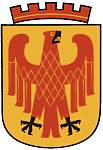 |
Home Towns - Potsdam, Germany
Basin Square |
 |



 |
This site is part of our Potsdam, Germany site. Click the left turn sign to get back to the
Potsdam Start Site.
 If you came here from our Vacation 2010 sites, click the green traffic light to return. |

|


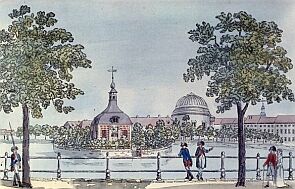 Original Basin Square, 1789
Original Basin Square, 1789 |
This used to be the largest of Potsdams baroque squares, but there is not much left of it. Like most of the area north of the river, this was originally not more than a swamp. It was drained between 1737 and 1739 as part of the construction of the Dutch Quarters. |
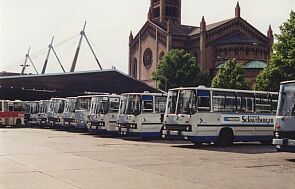 Basin Square Bus Terminal, 1994
Basin Square Bus Terminal, 1994
|
 Architect Johann Boumann designed a large Dutch style basin with a small pavillion in the center. However, due to poor circulation, the water quickly became murky and - especially on hot days - bad smelling. In 1876, the basin was filled up.  The pavilion in the squares center, called The Gloriette remained in place until the end of World War II, when it was demolished and eventually was replaced by a Russian Cemetery.  Starting in the 1970s, the square was used as the town's main bus terminal. With the construction of the new railway station in 2002, the bus terminal was moved and currently, most of the square is just a giant parking lot with occasional flee markets. |


| Dominating building at the square is the Catholic Church of St. Peter & Paul. |

 |
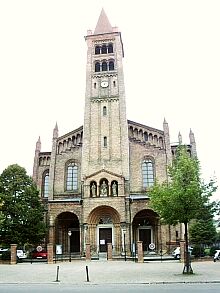 |

|

The Church of St. Peter & Paul, was built It is modeled after
the Basilica di San Zeno XXXX Interior picture borrowed from PotsdamWiki |
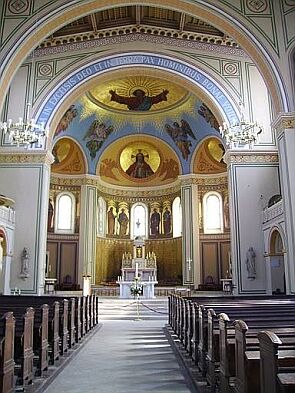 |
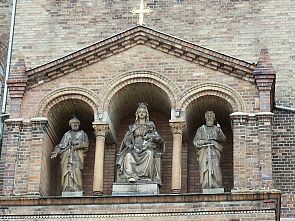
XXXSince the mid-1500s, Brandenburg has |


| A small church at the other end of the square survived everything the city had to endure over the last 250 years. |

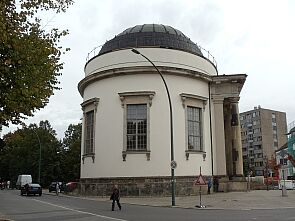 |
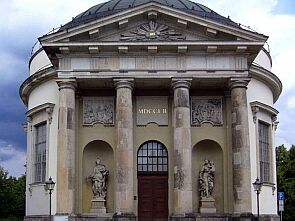 |
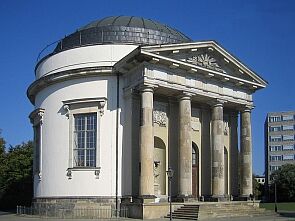
|
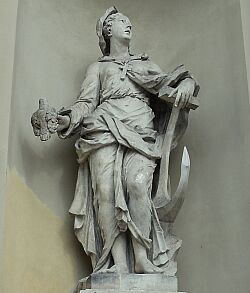 |
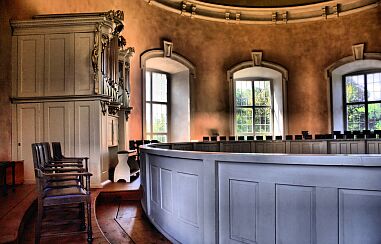
Interior picture |
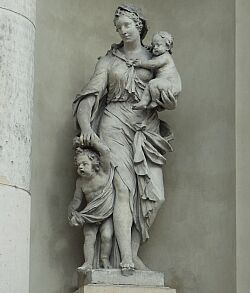 |

Being over 250 years old, the French Church
is the oldest still standing church in town. It was built in 1753 for the growing population of French Huguenots who followed Prussia's invitation to move to Potsdam and live free
from religious prosecution. The church was originally designed by Georg Wenzeslaus von Knobelsdorff, but was built under the supervision Johann Boumann, the lead architect of the Basin Square.  The interior was finished by Karl Friedrich Schinkel in 1833. This makes it the only church showing the art the two most famous Prussian architects Knobelsdorff and Schinkel in the same place. Sculptor Friedrich Christian Glume, the designer of the sculptures adorning Sanssouci Castle, also left his mark here, creating two statues, called Spes (Latin for hope) and Charitas (Latin for charity) to both sides of the gate. A Catholic and a Huguenot church in the center of Protestant Potsdam highlight one of the most noble traditions of the land: Tolerance. A cemetary between the two churches shows what happened, when the land forgot about that. |


| In the center of the square is a Russian Military Cemetery - final resting place for 383 Soviet soldiers. |

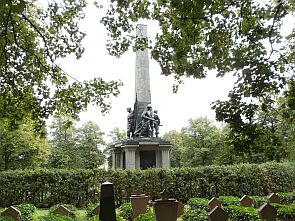 |
 |
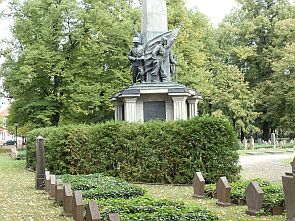
|
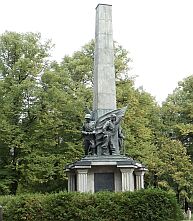 |
On April 27, 1945, the First Belorussian and the First
Ukrainian Army closed the Ring around Berlin not far from here. The then following
Battle of Berlin was the last battle of World
War II in Europe, claiming 81,000 Soviet and 480,000 German lives.  In 1946, the Soviet administration created a central cemetery for Soviet soldiers who died in or around Potsdam. Between 1946 and 1949, the remains of 383 soldiers were buried here, far away from home.  Central piece of the cemetery is a 62 feet tall obelisk, designed by German sculptor A. Brahms. It carries the statues of four soldiers, representing the four branches of the Soviet military service. |
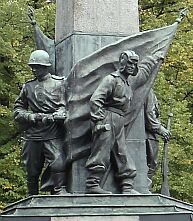
|
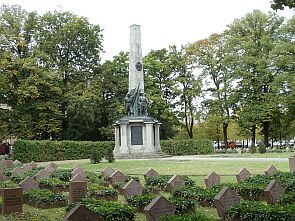 |
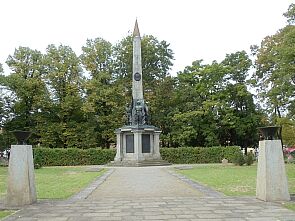 |

|



 |
This site is part of our Potsdam, Germany site. Click the left turn sign to get back to the
Potsdam Start Site.
 If you came here from our Vacation 2010 sites, click the green traffic light to return. |

|

 Back to Potsdam Page |
 Back to Home Towns |
 Back to Germany Page |
 Back to English Main Page |
 Back to Start Page |